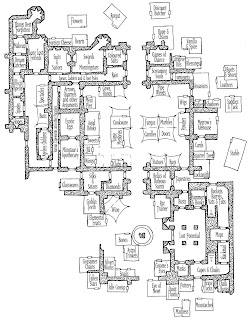Equipping characters remains an essential step in character creation. For OSR games and B/X D&D this step sometimes seems like one more bit of record-keeping on the character sheet, though choices like armor and weapons affect armor class and weapon damage. More recent entries into the fantasy roleplaying game stage have handled this differently, offering starting characters a choice of pre-determined kits based on race, class, or background. But after the initial adventure players can spend their characters’ gold as they please, often by perusing equipment lists like some medieval mail-order catalog, choosing the items they want, paying for them, and jotting them down on a character sheet.
Take a look at how some early rulebooks present equipment choices. Basic D&D (my preferred Moldvay edition) mentions generating a character’s starting money followed by the instruction to consult the equipment and weapons list as part of the “How To Create a Player Character” sequence (page B5). Everything’s listed on page B12, including weapons, armor, and 20 specific items necessary for dungeon adventuring. Each corresponds with related rules paragraphs later in the rulebook like “Light” (lantern, torches), “Doors” (iron spikes, hammer), “Encumbrance” (backpack, small and large sacks), and “Traps” (the infamous 10-foot wooden pole). The Expert D&D rules add four more items to this list, as well as expanding the weapon and armor offerings and lists for wilderness transport costs. The AD&D Players Handbook adds some lists for clothing, herbs, and other categories of goods characters can purchase, though most of these, too, relate directly to adventuring pursuits. The clothing list – possibly the one with the most potential for characters to splurge in establishing their visual identities – focuses mostly on varying kinds of boots, hats, and cloaks. These rules make no mention where characters might find these items in a civilized town, village, or keep, though “provisioner” seems to cover all these dungeon-delve-related items.
Coincidentally that same issue of Adventure Gaming (October 1981) included a lengthy overview and review of Chaosium’s Thieves’ World boxed set, which obviously pandered to my urge to explore medieval urban environments through D&D. The boxed set offered some inspiration for my equipment resources in the tables it used to randomly determine different businesses in various city neighborhoods. Those describing Sanctuary’s bazaar fixtures provided perhaps the best mix of services and goods relevant to adventurers seeking something more than a basic list of dungeon-delving gear: cartographer, camel dealer, scribe, fortuneteller, barber, and numerous others. These, too, fueled inspiration for my urban adventures, most of which took place in Sanctuary as a ready made medieval city.
Ruins of the Undercity provides another approach to shopping for equipment. It combines a random dungeon generator with the city-state of Cryptopolis as a base of operations. Characters spend 1d4+1 days searching for necessary items among the merchants and a similar amount of time finding and recruiting henchmen; each day carries with it the chance for a special encounter or event. Merchants have names evocative of the exotic desert setting, such as Mungoy’s Leathers, Brishnan Emporium, Hats of Sycophia, and the House of the Pole (with those infamous, trap-finding poles). Each shop consists of a table listing the merchandise it offers, the price, and a random die roll to determine the stock of the specific item carried. For instance, Dawd’s Market offers lanterns, but has only 1d4-2 in stock...meaning it might have none at the moment. The goods include those available on the standard rulebook equipment lists and others to add depth to characters: healing services, fashion accoutrements (outfits, hats, jewelry), writing supplies, a few magical items, spell scroll services. Ruins of the Underity presents a fulfilling sense of “going shopping” for dungeon-delving gear without simply picking things off a list.
 |
| Cartography by Dyson Logos. |
Each of these examples provides opportunities to infuse this mundane, downtime record-keeping task with setting elements that enhance the game world, whether it’s simply including evocative merchant names and exotic items or slipping a few scenario hooks and helpful contacts into the shopping experience. Some players might prefer the straightforward approach of shopping off a list and getting on with their adventures; but this aspect of the game offers some rich potential for character, setting, and plot development for inspired players.
I’m sure I’m missing some novel approaches to equipping characters, both initially and during campaigns. New fantasy roleplaying games and the continuing flood of innovative OSR approaches to classic forms can re-invent and expand this aspect of the game. What interesting approaches have you seen or developed to make this aspect of “character maintenance” come to life?
Comments....
Want to share your opinion? Start a civilized discussion? Share a link to this blog entry on Google+ and tag me (+Peter Schweighofer) to comment.

